Africa
South Africa Uses Survival Pools to Combat Drownings

In a small South African town’s playground, a red shipping container is visible.
The massive steel structure’s surprising purpose is to aid in saving children in a nation where drownings are on the rise.
The only swimming pool in a 25-kilometer radius is indoors, where kids may learn the fundamentals of staying afloat.
South Africa has thousands of kilometres of beaches, and swimming pools are scattered throughout the gardens in affluent areas.
However, according to a local rescue organisation, just one in seven South Africans is able to swim, and on average, four people drown each day.
Meiring Primary School, which houses the container in the Riebeek-Kasteel neighbourhood of Cape Town, has seen a drowning tragedy of its own.
A 12-year-old boy who died in a dammed lake at a nearby farm in 2021 is remembered with a framed picture in the foyer.
School principal Brenton Cupido remarked, “If he merely knew how to float in water, he may have saved his own life.”
READ ALSO: President Zelensky of Ukraine appoints Oby Ezekwesili as an ambassador
“Particularly in the summer, it becomes really hot here, and every afternoon, unaccompanied, our students swarm to the neighbouring dams.” “But the majority of them cannot swim.”
According to Jill Fortuin, the National Sea Rescue Institute’s director of drowning prevention, the toll is a “major public health issue” based on historical injustices.
Black people account for the majority of fatalities in South Africa.
Fortuin, who is herself of mixed descent, stated that “apartheid is a large piece of the problem.”
Swimming pools and vacation beaches were only accessible to the white minority during segregation, which made it difficult for the majority of people to learn how to swim.
Even now, three decades after democracy’s inception, there are still significant disparities and few chances.
Government schools, where the majority of underprivileged students attend, frequently lack swimming pools, according to Fortuin.
Most families, she continued, choose to put food on the table before paying for swimming lessons when given the option.
Swimming is not regarded as being important.
Safety water
In order to combat drowning, NSRI has placed 1,350 volunteer lifeguards on the nation’s beaches, and 1,500 bright pink buoys have been placed on various bodies of water to aid rescuers in helping persons in need.
However, the group, whose awareness-raising efforts have touched more than 3 million individuals in recent years, stressed the importance of prevention.
The demand is greater because of climate change-related floods and heat waves, according to Fortuin.
The idea for the “Survival Swimming Center” pool in Meiring came from 58-year-old drowning prevention manager Andrew Ingram.
Several of them keep some of “The kids don’t even have flushing bathrooms.” Then how in the world are they going to have a pool?” He queried.
“We give them access to clean water and a teacher.”
6 metres in length and 1 metre deep make up the container pool.
Children learn how to assist friends who are in need, regulate breathing, find their way under the water, and use an empty bottle as an emergency buoy.
According to Cupido, half of the students at the school now know how to float, and the majority of them are the first members of their families to do so.
One of the first students at Meiring’s survival pool, Jonathan Van der Merwe, used to be very “worried” that his daughter may get into danger in one of the many ponds surrounding the wine production region.
“I’m now feeling really at ease and comfortable about it,” he remarked.
KwaZulu-Natal, an eastern region that was devastated by catastrophic floods last year, will soon have a sister container erected at a school there. Another is already in place in the province of Eastern Cape.
About 100 youngsters between the ages of 6 and 12 have been taught survival swimming by Petro Meyer, 62, NSRI’s water safety teacher.
She remarked, “You should see their smiles when they understand for the first time that they are floating by themselves.” In these kids, “We aim to instil a new culture.”
